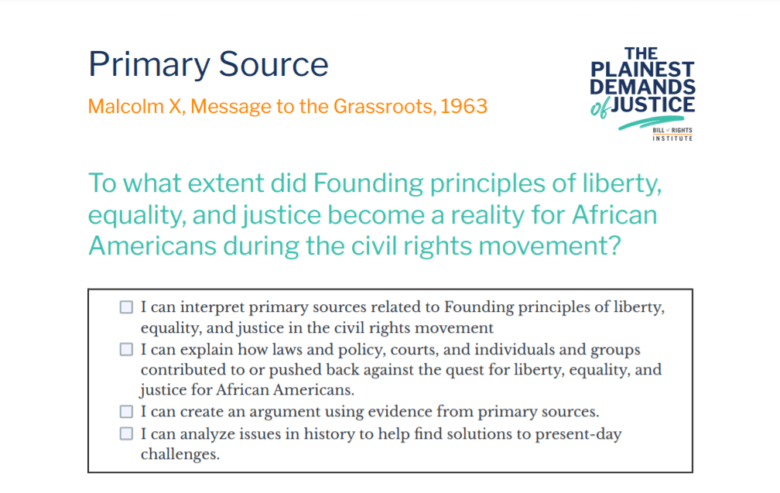Malcolm X, Message to the Grassroots, 1963
Get The Scaffolded Version
To what extent did Founding principles of liberty, equality, and justice become a reality for African Americans during the civil rights movement?
- I can interpret primary sources related to Founding principles of liberty, equality, and justice in the civil rights movement
- I can explain how laws and policy, courts, and individuals and groups contributed to or pushed back against the quest for liberty, equality, and justice for African Americans.
- I can create an argument using evidence from primary sources.
- I can analyze issues in history to help find solutions to present-day challenges.
Essential Vocabulary
| Integrationist | An activist whose goal was to integrate Blacks into white society |
| Turn-the-other-cheek | To not retaliate when harmed or insulted |
Building Context
Malcolm Little, better known as Malcolm X, was a prominent civil rights activist during the 1960s. He criticized the nonviolent integrationists within the movement, who believed that over time peaceful methods would end segregation and allow whites and Blacks to exist together. In contrast, Malcolm X believed in Black nationalism—a school of thought that advocated Black pride and self sufficiency and that urged Blacks to break away from white society and live on their own. Malcolm X also believed in the right of Blacks to defend themselves against police brutality. He gave the following speech at a civil rights conference in Detroit.
Malcolm X, Message to the Grassroots, 1963
Source: https://teachingamericanhistory.org/document/message-to-grassroots/
What you and I need to do is learn to forget our differences. When we come together, we don’t come together as Baptists or Methodists. You don’t catch hell ’cause you’re a Baptist, and you don’t catch hell ’cause you’re a Methodist . . . You catch hell ’cause you’re a black man . . .
And what we have foremost in common is that enemy—the white man. He’s an enemy to all of us. I know some of you all think that some of them aren’t enemies. Time will tell . . . First, what is a revolution? Sometimes I’m inclined to believe that many of our people are using this word “revolution” loosely, without taking careful consideration [of ] what this word actually means, and what its historic characteristics are.
You haven’t got a revolution that doesn’t involve bloodshed. And you’re afraid to bleed. I said, you’re afraid to bleed . . .
You don’t have a turn-the-other-cheek [to not retaliate when harmed] revolution. There’s no such thing as a nonviolent revolution. [The] only kind of revolution that’s nonviolent is the Negro revolution. The only revolution based on loving your enemy is the Negro revolution. The only revolution in which the goal is a desegregated lunch counter, a desegregated theater, a desegregated park, and a desegregated public toilet; you can sit down next to white folks on the toilet. That’s no revolution.
When you want a nation, that’s called nationalism . . . A revolutionary is a black nationalist. He wants a nation . . . If you’re afraid of black nationalism, you’re afraid of revolution. And if you love revolution, you love black nationalism . . .
Comprehension and Analysis Questions
- According to Malcolm X, who is the enemy of Black Americans?
- Why did Malcolm X criticize nonviolent methods of bringing about change?
- Compare the views and goals of Martin Luther King, Jr., and Malcolm X based on King’s words in Documents 5, 10, and 11. How is the difference between their approaches reminiscent of the divide between Black activists in the first half of the twentieth century? Consider the views of Booker T. Washington and W. E. B. Du Bois.
